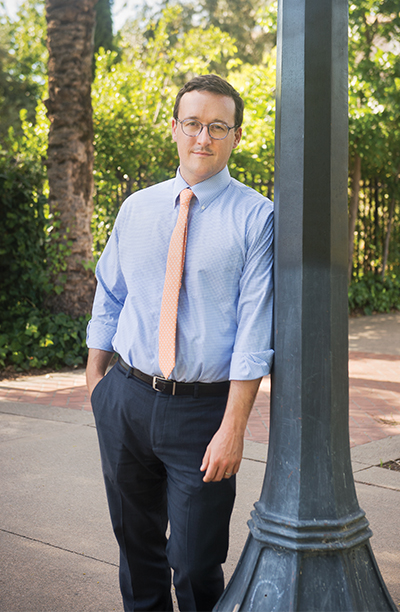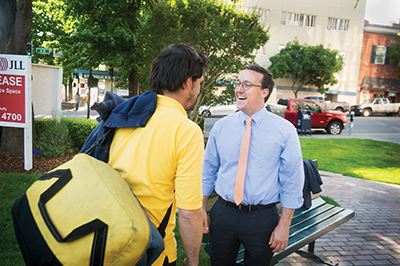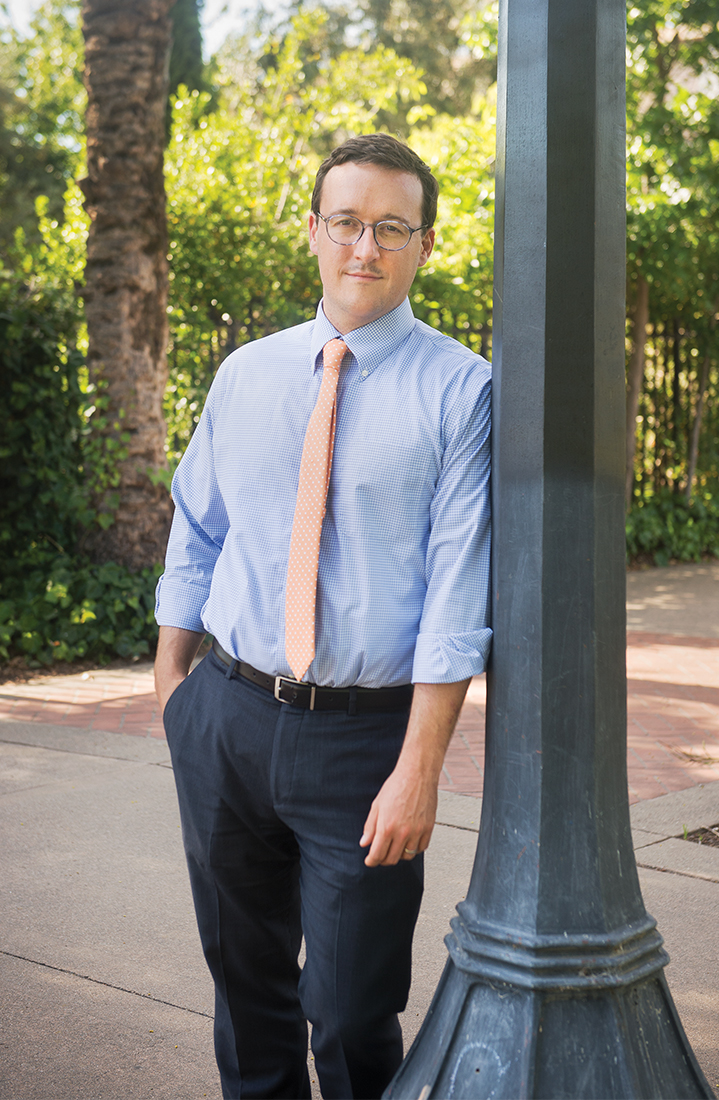
ANDREW HENING HAS a new job, and the job he’s taken is new. Earlier this year the University of Virginia grad was named San Rafael’s director of homeless planning and outreach. Hening’s previous position was as North Bay regional director of Downtown Streets Team, a Palo Alto–based nonprofit that helps homeless people empower themselves by cleaning up urban streets, sidewalks and parks. In that position for three years, he launched a Marin branch of DST in July 2013. Prior to that, he worked two years with DST in Santa Clara County and one year with the City of San Jose as the Santa Clara County Project Homeless Connect coordinator.
It’s obvious to many that Hening’s job was created in response to San Rafael’s growing homeless population (up 40 percent over 2013, according to the Marin Independent Journal) and the related increase in social problems such as panhandling, loitering and public drunkenness — all of which have negatively impacted downtown businesses and residents living close to the central part of San Rafael, Marin’s county seat.
Hening, 30, lives in Berkeley with his wife, Joanne, an assistant principal at an Oakland charter school. In their downtime the couple enjoys hiking, camping and mountain-biking throughout Northern California. In addition, Hening is studying for his MBA at UC Berkeley’s graduate Haas School of Business. His three-year contract with the City of San Rafael calls for an annual salary of $105,252.
Is it valid to say that there are approximately 1,300 homeless people in Marin County, most of them in and around San Rafael, and it’s only about 40 of them who cause most of the problems? During my time in Santa Clara County, an organization called Destination: Home utilized national data to put people in buckets, or categories, of homelessness. I largely agree with their interpretation. The first group represent what I’ll call “episodic” homelessness, and they are about 50 percent of the homeless community. Of the almost 1,300 people who are homeless in Marin, about 600 are in this group. These are people who have lost a job, recently divorced or experienced a medical catastrophe that wiped out their savings. We now realize the best way to help them is to never let them become homeless in the first place; that’s far easier than finding them housing once they become homeless. And, in the past year, the Help Desk at Saint Vincent de Paul has given out rental assistance checks to over 1,000 families or individuals in an effort to see that happen. A second bucket of homelessness, comprising 40 percent of Marin’s homeless, includes people who have what I call “exacerbating conditions.” These are people who have been homeless on and off for maybe one to five years, or in some cases much longer. These folks have substance abuse or mental health challenges that while problematic are somewhat under control. They are in AA or taking their medications. These are also people who might have aged out of the foster care system, who have a criminal background, or have some other prolonged challenge to regaining housing. These are people we can work with, we can help them; if you see someone in the Downtown Streets Team program, they are more than likely in this group. In the last bucket are the 10 percent referred to in your question. These are the severely mentally impaired people with schizophrenia, bipolar, those kinds of diseases, and severe substance abusers such as acute alcoholism or crystal meth or heroin users. Oftentimes people are actually using drugs and alcohol to treat their mental health challenges. These people are the people who don’t realize they have a problem. These are the people who cause most of the problems, and in San Rafael, there are around 40 of them.
What is being done, or what can be done, to get them off the streets? In the last few months, we’ve formed HOT, or Homeless Outreach Team. It’s composed of agencies such as Saint Vincent’s and Ritter Center, as well as the San Rafael police, County Health and Human Services people and myself, who meet every Monday; there are about 12 of us, and our primary focus are these hardestto- help individuals. Our goal is to get them housed, to get them sober enough to realize that they need help, and then get them that help. We know who these people are, we know their names and they’ve signed releases that allow us to talk about them within our HOT group. Lynn Murphy with the San Rafael police has been a tremendous asset in this effort. Oftentimes policy seeks to affect these individuals as an overall group. That doesn’t work. In our meetings we treat and triage each person as an individual because they are as distinct from one another as anyone you or I may know. We keep track of them and try to act immediately if one of them is obviously off his or her medications. Again, the goal is to get them sober or stabilized enough to realize they need help. It’s a slow and demanding process and HOT is a scrappy group, currently without funding, working pro bono to solve this problem. A lot of credit should go to Christine Paquette, the executive director of Saint Vincent de Paul in Marin, who helped spearhead the idea initially.
Getting back to the core problem causers, why can’t something be done when one of them passes out drunk on a sidewalk or defecates in a doorway? While I recognize what you’re asking, I want to tell you that San Rafael police can get over 10 calls a day — most of them 911 calls — regarding just one individual chronic inebriate who is lying on a sidewalk passed out. Some of these inebriates have abused their bodies through substance abuse so much that they have lost control of their bowels. It is a horrible problem. But there is a new county program for chronic inebriates called Transitions; four of our targeted group members are in there now and they are making progress on maintaining sobriety and regaining control of their medical issues. Remember, people have to give their consent to receiving treatment; we can’t force someone to stop drinking. We can encourage them to stop, but we can’t make them stop. As frustrating as it is for the public, it’s just as frustrating for providers like us.

Aren’t there laws against public drunkenness and loitering? Why can’t they be enforced? As much as we sometimes wish it would, criminal justice intervention is not going to solve homelessness. When people are alcoholics, mentally ill or substance abusers, it’s been well proven that criminal justice intervention does not work. We’ve been fighting the war on drugs my entire life — I don’t see any victory on that front yet. Sure, the police can go and cite these people a million times for public intoxication and loitering, but to what end? These people are homeless and broke and can’t pay fines or post bail; getting arrested is a slap on the wrist. If anything, time in jail is a respite for them; they’d go up there and are guaranteed a warm bed and three meals a day. Also, criminalizing behavior associated with homelessness is a slippery legal slope. If, for example, you start criminalizing sitting on the sidewalk as loitering, what happens to the mom who stops to tie her shoe and leans up against a building? If you don’t arrest her, some will say it’s a discriminatory type of law. To frame this conversation in a different way, I think a lot of homeless people would gladly like a place to go during the day, a place where they could just be. Downtown Streets Team is proof that homeless people do want to be involved in the community and give back. It’s about providing those opportunities. If they go to a park, and people get angry with them, where can they go? If we don’t have enough shelter beds, what’s the alternative but to have people sleep in front of businesses or in the open space? It’s very frustrating. If we had an option for the homeless, we might not be having this conversation, but as it stands now, there are very few options.
Over the years, there has been talk of creating a place for the homeless to go, a place for them to receive needed treatment, but nothing seems to happen. Are any such plans currently afoot? Absolutely. Ideally, this would be a multiservice center. Palo Alto has one now; it’s called Opportunity Center and it’s located near a prominent shopping center and there have been very few spillover problems reported over the 10 years it’s been in existence. Meanwhile, the homeless problem in downtown Palo Alto has been greatly reduced. Between 2005 and 2013, homelessness decreased by over 50 percent. In Marin, we’re trying to find a location that accommodates all the services now offered by Ritter Center and Saint Vincent’s. That includes mental health services, food services, showers, laundry, AA meetings, even Wi-Fi services and places to charge their phones. It could also include a shelter component, places to sleep; the Marin Employment Connection could have an office there, along with housing search offices. It would be a great place to be, and also a place to get involved in changing a lifestyle.
Location has long been a problem. Where could a Marin multiservice center be located so that NIMBYism would be minimized? A location in a northern San Rafael industrial park is now getting considerable attention. It’s near county employment offices on Smith Ranch Road; also, the Helen Vine Detox Center is nearby, as is Homeward Bound in Novato. Shuttles could operate between all these services as well as downtown San Rafael. The goal would be to contain it at the end of Mark Drive so that it is a place homeless people want to be. The building is separated from any residential by Gallinas Creek and considerable privacy fencing.
Realistically, what would be the timing for a multiservice center in Marin? If we can come to an understanding of what will be there, make an offer on the property and have it accepted, and then have the use permit and public hearing process go relatively smoothly, by the end of the calendar year we might have a thumbs-up or thumbs-down decision on moving forward. After that would come tenant improvements and actually moving services, so optimistically, we could be operational inside 18 months.
Speaking of that, you have a three-year contract to be San Rafael’s director of homelessness planning and outreach. What is your three-year goal? I have no interest in managing homelessness; I am trying to end it. I love having the three-year time restraint. So ideally, within that time period, the City of San Rafael will have in place programs and structures that will be self-sustaining and no longer call for the position I now hold. Establishing the multiservice center is my number one goal. My number two goal is to continue working and building a great relationship between the city and the county’s health and human services department. If I can achieve these first two, I will achieve my final goal, which is working myself out of a job.
This article originally appeared in Marin Magazine’s print edition under the headline: “Andrew Hening.”


